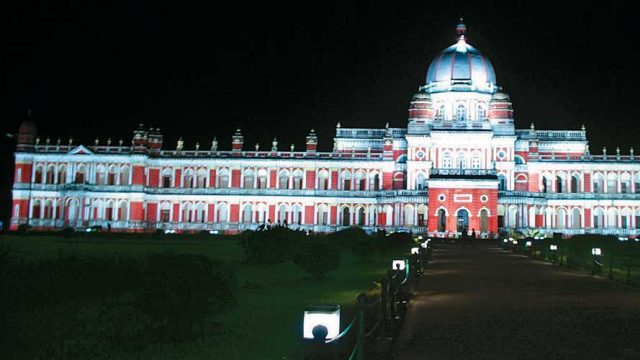Cooch Behar, a quiet, unobtrusive small town, used to be a seat of princely grandeur. Its opulence in the heyday of the rule of Cooch Behar’s Narayan-Koch kings lasted till India’s independence in 1947. What remains of that legacy is the architecture. Burnt red-brick structures highlighted by arches, cornices and Corinthian columns are scattered all over town, particularly around Sagar Dighi tank.
The landscape of the town is marked by at least 22 tanks. The Torsa River, flowing down from the Eastern Himalaya, runs alongside the town before taking off towards Bangladesh. Besides the temples dotting the town, the real draws are the indigenous people of Cooch Behar District – Rajbanshi, Toto, Gorkha, Mech, Rabha, Lepcha and Bhutia – whose distinctive dress and traditions are just as attractive as memories of a once-flourishing royalty.
Things to See & Do
The 19th-century Cooch Behar Royal Palace was built on classical Italian lines. Its construction began during the reign of Maharaja Nripendra Narayan, and was completed in 1887.
A part of it is now a wonderful museum that is worth visiting. It showcases imported oil paintings and chandeliers, sepia-tinted photographs of royalty, antiquities and much more unearthed from Gosanimari, where the old capital of the Koch kings was located. Laterite and sandstone sculptures from as far back as the 7th century CE are also on display, although, unfortunately, only a few are intact. A gallery shows the lifestyle of Cooch Behar’s indigenous people.

The most spectacular of the town’s 22 tanks is Sagar Dighi, with grand structures all around it. The buildings around the tank, built mostly between the 1880s and 1920s, are now the offices of the district administration. A popular hangout in the evenings, the tank attracts beautiful migratory birds in winter.
The Madan Mohan temple complex has a dazzling white one-storeyed structure as its centrepiece. It’s a fine blend of Hindu (low, sprawling porch in the front), Islamic (scalloped arches and bulbous pillars) and Central Asian (dome with tapered peak) architectural traditions.
Another temple, the Baneshwar Shiva Temple, has an interesting roof in the Bengali do-chala (parted on top and slanting on either side) style.
Madhupur Dham, a serene retreat, is dedicated to the Vaishnavite spiritual guru Shankar Dev, who fled his native Assam in the 16th century to avoid persecution by the rulers, and found asylum with Koch king Nara Narayan.
Where to Stay & Eat
Hotel Ellora (Tel: 03582-224318, 222125; Tariff: ₹800–4,100), near the palace, and Benfish’s Maharaja Tourist Complex (Tel: 223094; Tariff: ₹400–1,000) are the best choices. The other options are Hotel Royal Palace (Tel: 222210, 230731; Tariff: ₹900–3,000) and Yubraj Hotel (Tel: 231710, 227885; Tariff: ₹800– 3,000). You have the option of eating at the hotel restaurants or visiting the Mall, which is located opposite the palace.
The Information
When to go November–March; December–January for migratory birds
Tourist/ Wildlife Offices
Tourist Information Centre, Zila Parishad Athithi Nivas, Kutcheri Modh Suniti Road, Cooch Behar, Tel: 03582-231527
STD code 03582
Getting There
Air Nearest airport: Bagdogra (150km/ 5.5hrs) connected to Delhi, Kolkata and Guwahati. Taxi costs about ₹3,000
Rail New Cooch Behar Station is connected to major cities
Road From Siliguri, take state highway to Managuri; SH and NH31 to Cooch Behar via Dhupguri and Sonarpur Bus North Bengal STC buses regularly run from Siliguri Junction between 6.00am and 6.00pm




